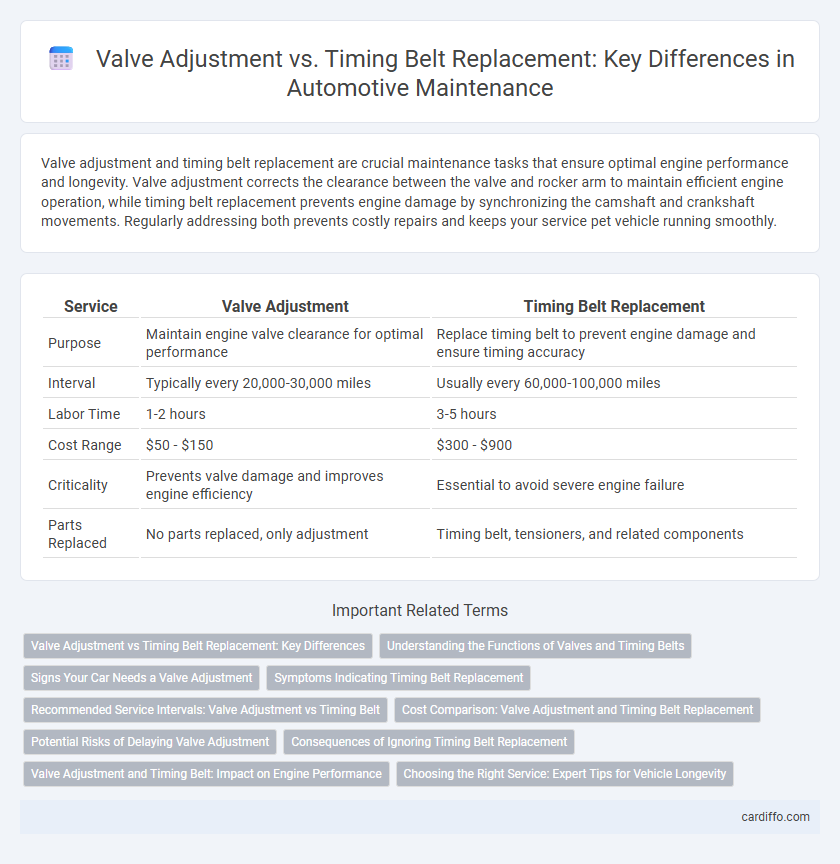Valve adjustment and timing belt replacement are crucial maintenance tasks that ensure optimal engine performance and longevity. Valve adjustment corrects the clearance between the valve and rocker arm to maintain efficient engine operation, while timing belt replacement prevents engine damage by synchronizing the camshaft and crankshaft movements. Regularly addressing both prevents costly repairs and keeps your service pet vehicle running smoothly.
Table of Comparison
| Service | Valve Adjustment | Timing Belt Replacement |
|---|---|---|
| Purpose | Maintain engine valve clearance for optimal performance | Replace timing belt to prevent engine damage and ensure timing accuracy |
| Interval | Typically every 20,000-30,000 miles | Usually every 60,000-100,000 miles |
| Labor Time | 1-2 hours | 3-5 hours |
| Cost Range | $50 - $150 | $300 - $900 |
| Criticality | Prevents valve damage and improves engine efficiency | Essential to avoid severe engine failure |
| Parts Replaced | No parts replaced, only adjustment | Timing belt, tensioners, and related components |
Valve Adjustment vs Timing Belt Replacement: Key Differences
Valve adjustment involves fine-tuning the clearance between the valves and rocker arms to ensure optimal engine performance and prevent damage, typically required every 20,000 to 30,000 miles. Timing belt replacement is a more critical maintenance task that involves changing the belt responsible for synchronizing the engine's camshaft and crankshaft, usually recommended every 60,000 to 100,000 miles depending on the vehicle. While valve adjustment maintains engine efficiency, timing belt replacement is essential to avoid catastrophic engine failure.
Understanding the Functions of Valves and Timing Belts
Valves regulate the flow of air and fuel into the engine cylinders and control exhaust gas release, ensuring proper combustion and engine performance. Timing belts synchronize the rotation of the crankshaft and camshaft, maintaining precise valve timing to prevent engine damage. Understanding these functions highlights the importance of valve adjustment for optimal engine efficiency and timing belt replacement to avoid costly mechanical failures.
Signs Your Car Needs a Valve Adjustment
Signs your car needs a valve adjustment include rough idling, excessive engine noise, and decreased fuel efficiency. A tapping or clicking sound from the engine often indicates valve clearance issues, which can lead to poor engine performance if not addressed. Ignoring these symptoms risks engine damage, making timely valve adjustment essential for maintaining vehicle health.
Symptoms Indicating Timing Belt Replacement
Symptoms indicating timing belt replacement include unusual engine noises such as ticking or rattling sounds, engine misfires, and difficulty starting the vehicle. Visible signs like cracks, fraying, or glazing on the timing belt surface also signal the need for immediate replacement. Ignoring these symptoms can lead to severe engine damage and costly repairs.
Recommended Service Intervals: Valve Adjustment vs Timing Belt
Valve adjustment is typically recommended every 30,000 to 60,000 miles to maintain optimal engine performance, while timing belt replacement intervals range from 60,000 to 100,000 miles depending on the vehicle manufacturer. Regular valve adjustments ensure proper engine valve clearance, preventing engine damage and promoting fuel efficiency. Failure to replace the timing belt within the recommended interval risks catastrophic engine failure due to belt breakage or slippage.
Cost Comparison: Valve Adjustment and Timing Belt Replacement
Valve adjustment typically costs between $100 and $400, depending on the vehicle model and labor rates, whereas timing belt replacement can range from $500 to $1,000 due to the complexity and parts involved. Timing belt replacement often includes additional components like water pumps and tensioners, increasing the overall expense compared to the relatively straightforward valve adjustment service. Regular valve adjustments are less frequent and less costly, but neglecting timing belt replacement can result in severe engine damage, making the higher upfront investment essential for vehicle longevity.
Potential Risks of Delaying Valve Adjustment
Delaying valve adjustment can cause uneven engine wear, leading to decreased fuel efficiency and compromised performance. Neglected valve clearances increase the risk of valve damage, resulting in costly repairs or engine failure. Regular valve adjustment alongside timing belt replacement ensures optimal engine timing and prevents mechanical breakdowns.
Consequences of Ignoring Timing Belt Replacement
Ignoring timing belt replacement can lead to severe engine damage, including valve misalignment and potential engine failure. A broken timing belt disrupts the synchronization between the camshaft and crankshaft, causing pistons to collide with valves and resulting in costly repairs. Regular valve adjustment alone cannot prevent the catastrophic consequences associated with a neglected timing belt.
Valve Adjustment and Timing Belt: Impact on Engine Performance
Valve adjustment ensures optimal clearance between the valves and rocker arms, which maintains efficient engine combustion and prevents power loss. Timing belt replacement is critical for synchronizing the camshaft and crankshaft, ensuring precise valve timing and preventing severe engine damage. Proper maintenance of both valve adjustment and timing belt significantly enhances engine performance, fuel efficiency, and longevity.
Choosing the Right Service: Expert Tips for Vehicle Longevity
Valve adjustment ensures optimal engine performance by maintaining proper clearance between the valve and rocker arm, preventing engine misfires and improving fuel efficiency. Timing belt replacement is critical to avoid catastrophic engine damage, as a worn belt can break and cause valve collision with pistons, leading to costly repairs. Regularly scheduling both services according to manufacturer guidelines extends engine lifespan and enhances vehicle reliability.
Valve Adjustment vs Timing Belt Replacement Infographic

 cardiffo.com
cardiffo.com